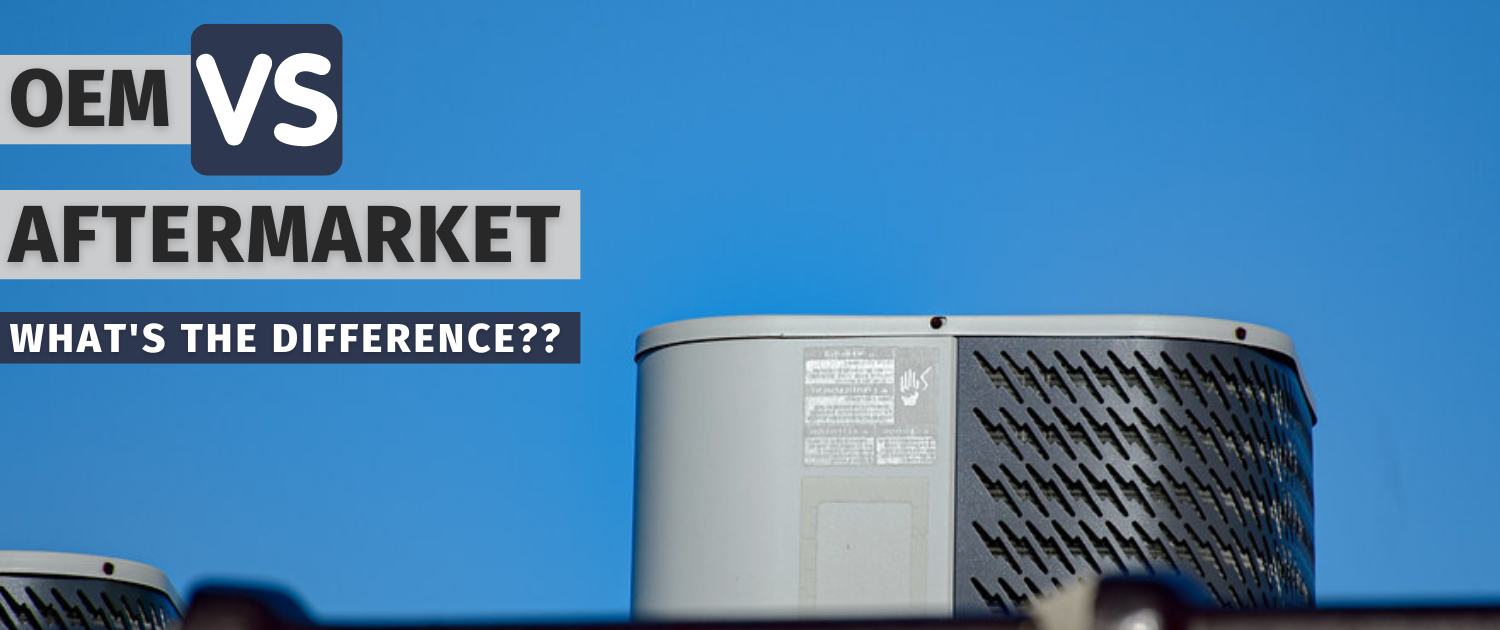OEM vs. Aftermarket: What’s The Difference?
Anyone who’s had a car repaired or their HVAC system or a home appliance serviced has probably heard the terms “OEM” and “Aftermarket” in reference to replacement parts. You may not have known what the difference was (besides price) and let your repair person or even insurance company make the final decision about which parts to use. Allow us to unmuddy the waters and give you the facts.
What is OEM?
OEM refers to “Original Equipment Manufacturer,” meaning that the parts are made by the manufacturer who built the equipment that needs the replacement part(s).
For example, if your Rheem gas furnace stops working and needs a new control board, the OEM replacement furnace control board made by Rheem (or their chosen surrogate) can be used to replace the original Rheem control board that came with your furnace when it was initially purchased and installed.
It fits into your furnace model perfectly because it was designed expressly for your Rheem furnace and other Rheem models.
Also Read: Market size of automotive OEM coatings
What is Aftermarket?
Aftermarket parts are made by a third-party company and are most often form, fit, and functional replacements for one specific manufacturer’s part. Reputable aftermarket manufacturers, like ICM Controls, make replacement parts that are just as good if not identical to the part you need, but they’re not made by the same company that manufactured the original part that came with your equipment (although sometimes they are, more on that shortly).
Some aftermarket manufacturers do make universal parts that are replacement parts for many different manufacturers’ products, but in general, this is done as a convenience to the technicians servicing a variety of brands.
It’s a good idea to understand who is making the aftermarket part you’re purchasing and where it’s being made. There are less reputable suppliers out there who import low-quality aftermarket parts that don’t perform as intended and can affect the performance or lifespan of the equipment you’re repairing.
Also Read: The Projected size of the U.S. automotive aftermarket between 2020 and 2024
OEM vs. Aftermarket: Difference in Price
OEM parts tend to cost more than Aftermarket parts because they are manufactured to fit the specifications of a specific type of equipment, such as a gas furnace. Aftermarket parts can usually save you a little bit of money because they are designed to fit several different types of equipment and have fewer steps along the supply chain, which helps contain costs.
OEM parts go from the manufacturer to OEM to distributor to dealer to you and get marked up along the way, so everyone makes a profit. Aftermarket parts have fewer intermediaries, which can save you money.
OEM vs. Aftermarket: Differences in Design, Quality & Functionality
OEM parts are exact replacement parts and were specifically designed to duplicate the part used when your equipment was first built. The quality of an OEM part is guaranteed to be the same (or at least strikingly similar) as the part already used on your equipment or vehicle.
Aftermarket parts are often reverse-engineered. Because of this, the quality can vary depending on the manufacturer and country of origin. This may mean the aftermarket part may not function exactly as needed or last as long.
American-made parts are generally regarded to be of better quality.
To complicate things a bit more, it’s important to note that aftermarket parts can be made by the same company that made them for your original piece of equipment.
ICM Controls supplies many OEM parts for an array of OEMs and the aftermarket. At ICM, many OEM and aftermarket parts are one and the same. The branded OEM part is identical to the aftermarket part.
OEM vs. Aftermarket: Warranty & Availability
While replacement parts from various manufacturers have different warranty periods, OEM products tend to have the shortest warranty period – between 30 and 90 days. Aftermarket suppliers are usually more generous with their warranty period, offering up to a year after purchase.
This is not to say that there is an aftermarket replacement part option for every OEM part. In specific industries, like lawncare equipment, OEM parts rule, and there are very few aftermarket parts available.
| OEM Parts | Aftermarket Parts |
| Made by the equipment’s manufacturer | Made by a third-party company |
| Good quality | Quality can vary by manufacturer and where it’s made |
| More expensive | Less expensive (no middle-man) |
| Better availability | Only certain replacement parts are available |
| Shorter warranty period | Better warranty |
Which one should I choose? OEM or Aftermarket?
The answer is “it depends” and hinges on what part you’re replacing in what kind of a system or equipment. Most maintenance specialists know when an OEM vs. Aftermarket part makes a difference, and they’ll tell you when it matters and when it’s perfectly okay to save some money. Some auto insurance companies only pay for aftermarket parts, but you can always elect to pay the difference if/when you believe the OEM part is the better choice.
Both OEM and aftermarket part manufacturers are regulated and inspected. The only difference is who makes the parts. Some people feel strongly about using OEM parts, particularly if they are repairing a new car or restoring an old one. Some people have no preference whatsoever and are focused on saving money where they can.
The best way to tell a quality aftermarket company from a less reputable one is to take a look at their offerings. Do their parts come with warranties? Are there installation videos and helpful blogs on their website?
Do they offer technical support and have a customer service help-line that’s based in the US? Aftermarket companies that look like they care about their parts and customers usually do.










